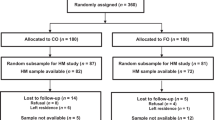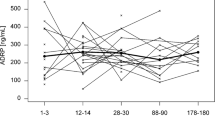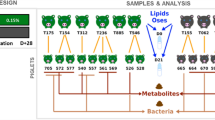Abstract
Background/objectives
Diet westernization in Hong Kong may increase trans fat intake, whereas it may decrease intake of polyunsaturated fatty acids. The present study was to determine the current breast milk fatty acid composition and trans fat intake by Hong Kong lactating mothers.
Methods
Sixty lactating women were recruited for the study. Each participant donated 15 ml of milk at week 4 and 6 after delivery. Dietary data were collected using a 3-day food record method, covering 2 weekdays and 1 weekend day. Milk fatty acids were analyzed using a gas chromatography method. Trans fat consumption was assessed using the Nutrition Data System for Research or calculating the intake based on percentage of trans fatty acids in the breast milk.
Results
Linoleic acid, α-linolenic acid, arachidonic acid, and docosahexaenoic acid in breast milk were 16.23%, 1.52%, 0.59%, and 0.66% total milk lipids, respectively. Mean daily intakes of total fat, saturated fatty acids, monounsaturated fatty acids, were 79, 24, 29, and 18 g, respectively. Total trans fat intake was estimated to be 1.15–1.20 g daily and accounted for 0.50–0.52% total energy.
Conclusions
Breast milk of Hong Kong Chinese lactating women contained relatively higher contents of arachidonic and docosahexaenoic acids compared with those of Western countries. Compared with the previous study conducted in 1995, breast milk total trans fatty acids in 2018 still remained low. Total trans fat intake by Hong Kong lactating women in 2018 was a half of WHO’s recommendation that total trans fat intake should be <1% total energy.
This is a preview of subscription content, access via your institution
Access options
Subscribe to this journal
Receive 12 print issues and online access
$259.00 per year
only $21.58 per issue
Buy this article
- Purchase on Springer Link
- Instant access to full article PDF
Prices may be subject to local taxes which are calculated during checkout

Similar content being viewed by others
References
Nestel P. Trans fatty acids: are its cardiovascular risks fully appreciated? Clin Ther. 2014;36:316–21.
Ooi EMM, Watts GF, Ng TWK, Barrett PHR. Effect of dietary fatty acids on human lipoprotein metabolism: a comprehensive update. Nutrients. 2015;7:4416–25.
Mennitti LV, Oliveira JL, Morais CA, Estadella D, Oyama LM, Oller do Nascimento CM, et al. Type of fatty acids in maternal diets during pregnancy and/or lactation and metabolic consequences of the offspring. J Nutr Biochem. 2015;26:99–111.
Decsi T, Burus I, Molnár S, Minda H, Veitl V. Inverse association between trans isomeric and long-chain polyunsaturated fatty acids in cord blood lipids of full-term infants. Am J Clin Nutr. 2001;74:364–8.
Food and Environmental Hygiene Department. Hong Kong population-based food consumption survey 2005–2007, Final Report. Hong Kong: Food and Environmental Hygiene Department, HKSAR; 2010. p. 48–50.
Woo KS, Chook P, Raitakari OT, McQuillan B, Feng JZ, Celermajer DS. Westernization of Chinese adults and increased subclinical atherosclerosis. Arterioscler Thromb Vasc Biol. 1999;19:2487–93.
Census and Statistics Department. Women and men in hong kong key statistics. Hong Kong: Census and Statistics Department, HKSAR; 2018. p. 90–3.
Elder S, Schmidt D. Global employment trends for women. Geneva: Employment Strategy Department, International Labour Office; 2004. p. 9–13.
Chen ZY, Pelletier G, Hollywood R, Ratnayake WMN. Trans fatty isomers in Canadian human milk. Lipids. 1994;30:15–21.
Mojska H. Influence of trans-fatty acids on infant and fetus development. Acta Microbiol Pol. 2003;52:67–74.
Chen ZY, Kwan KY, Tong KK, Ratnayake WMN, Li HQ, Leung SSF. Breast milk fatty acid composition: a comparative study between Hong Kong and Chongqing Chinese. Lipids. 1997;32:1061–7.
Butts C, Hedderley D, Herath T, Paturi G, Glyn-Jones S, Wiens F, et al. Human milk composition and dietary intakes of breastfeeding women of different ethnicity from the Manawatu-Wanganui region of New Zealand. Nutrients. 2018;10:1231.
Kim H, Kang S, Jung BM, Yi H, Jung JA, Chang N. Breast milk fatty acid composition and fatty acid intake of lactating mothers in South Korea. Br J Nutr. 2017;117:556–61.
Tian HM, Wu YX, Lin YQ, Chen XY, Yu M, Lu T, et al. Dietary patterns affect maternal macronutrient intake levels and the fatty acid profile of breast milk in lactating Chinese mothers. Nutrition. 2019;58:83–88.
Thakkar SK, De Castro CA, Beauport L, Tolsa JF, Fischer Fumeaux CJ, Affolter M, et al. Temporal progression of fatty acids in preterm and term human milk of mothers from Switzerland. Nutrients. 2019;11:112.
Daud AZ, Mohd-Esa N, Azlan A, Chan YM. The trans fatty acid content in human milk and its association with maternal diet among lactating mothers in Malaysia. Asia Pac J Clin Nutr. 2013;22:431–42.
de Souza Santos da Costa R, da Silva Santos F, de Barros Mucci D, de Souza TV, de Carvalho Sardinha FL, Moutinho de Miranda ChavesCR, et al. Trans fatty acids in colostrum, mature milk and diet of lactating adolescents. Lipids. 2016;51:1363–73.
Craig-Schmidt MC, Weete JD, Faircloth SA, Wickwire MA, Livant EJ. The effect of hydrogenated fat in the diet of nursing mothers on lipid composition and prostaglandin content of human milk. Am J Clin Nutr. 1984;39:778–86.
Miliku K, Duan QL, Moraes TJ, Becker AB, Mandhane PJ, Turvey SE, et al. Human milk fatty acid composition is associated with dietary, genetic, sociodemographic, and environmental factors in the CHILD Cohort Study. Am J Clin Nutr. 2019. https://doi.org/10.1093/ajcn/nqz229.
García-Ravelo S, Díaz-Gómez NM, Martín MV, Dorta-Guerra R, Murray M, Escuder D, et al. Fatty acid composition and eicosanoid levels (LTE4 and PGE2) of human milk from normal weight and overweight mothers. Breastfeed Med. 2018;13:702–10.
Mohammad MA, Haymond MW. Regulation of lipid synthesis genes and milk fat production in human mammary epithelial cells during secretory activation. Am J Physiol Endocrinol Metab. 2013;305:E700–716.
Smith S. Mechanism of chain length determination in biosynthesis of milk fatty acids. J Mammary Gland Biol Neoplasia. 2009;14:245–60.
Lönnerdal B. Effects of maternal dietary intake on human milk composition. J Nutr. 1986;166:499–513.
Acknowledgements
We thank the Health and Medical Research Fund (HMRF) of the Food and Health Bureau of the Government of the Hong Kong Special Administrative Region for supporting this research. We would like to thank all mothers who donated milk samples and their participation in this research.
Author information
Authors and Affiliations
Contributions
PSPY and TFJC were responsible for collecting the milk samples and conducting the dietary survey. ZH was responsible for carrying out the statistical analyses. LKL and SFSL were responsible for recruiting the lactating mothers. ZYC supervised and led the project.
Corresponding author
Ethics declarations
Conflict of interest
The authors declare that they have no conflict of interest.
Additional information
Publisher’s note Springer Nature remains neutral with regard to jurisdictional claims in published maps and institutional affiliations.
Supplementary information
Rights and permissions
About this article
Cite this article
Yip, P.S.P., Chan, T.F.J., He, Z. et al. Quantification of breast milk trans fatty acids and trans fat intake by Hong Kong lactating women. Eur J Clin Nutr 74, 765–774 (2020). https://doi.org/10.1038/s41430-020-0604-9
Received:
Revised:
Accepted:
Published:
Issue Date:
DOI: https://doi.org/10.1038/s41430-020-0604-9



